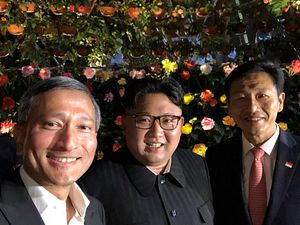On Monday evening, Singaporean Foreign Minister Vivian Balakrishnan took to Twitter to share a selfie of him and North Korean leader Kim Jong-un at Singapore’s famous Marina Bay Sands casino. Balakrishnan has been tasked with making a nervous Kim Jong-un feel at home on his furthest trip from North Korea since assuming the reins there after his father’s death in 2011.
As his summit with U.S. President Donald Trump nears, Kim has reason to be nervous. Coming to Singapore presents him with risks back home — risks of his power being usurped in a coup — and risks to his person. North Korea was sharply concerned about security leading up to the summit. But even with these concerns and risks, Kim saw it fit to enter his bullet-proof stretch Mercedes — ported over from North Korea — and tour Singapore, Asia’s lion city, by night.
And Kim seemed to have enjoyed himself.
The selfie posted by the Singaporean foreign minister shows a grinning Kim, donning his tortoise-shell glasses. The North Korean leader, in his mid-30s, might not have even looked out of place at Marina Bay Sands had it not been for his distinctive striped Mao suit and his massive security entourage. The photograph was likely Kim Jong-un’s first-ever selfie — giving us a glimpse at Kim that is a far cry from the carefully managed and altered photographs released to international press by North Korea’s state-run media.
The photograph has drawn mixed reactions. Many have been quick to point out that it isn’t the best look for Singapore’s Balakrishnan to be seen grinning alongside a man who just 16 months earlier had ordered his half-brother killed in an attack at Kuala Lumpur International Airport, some 200 miles north of Marina Bay Sands in Singapore. Kim was also responsible for killing his uncle, who he is rumored to have perceived as a threat to his own power.
Similarly, Kim Jong-un presides over a brutal totalitarian regime culpable for crimes against humanities. Michael Kirby, the head of the United Nations Commission of Inquiry on human rights in North Korea, had famously commented some years ago that conditions in North Korea approximated a “Holocaust-type phenomenon.”
If there ever was a pariah state on the international stage, it is North Korea. Its human rights record and defiance of United Nations Security Council sanctions over the years have earned it a reputation as the world’s most dangerous — and worst-behaved — country. The moniker ‘mafia state’ is often applied to the country too, accurately capturing North Korea’s status as the only known state sponsor of counterfeit U.S. dollar bill and methamphetamine production.
This reputation has cost North Korea. It has buckled under UN sanctions for years and continues to be one of the poorest and least-connected countries on earth. As I’ve noted in these pages recently, North Korea’s ongoing diplomatic charm offensive is motivated by a desire for economic betterment. In the pursuit of these objectives, Kim’s night out with Balakrishnan is more than just a surreal moment in international diplomacy.
To normalize North Korea — a country known and caricatured for its presumed strangeness — Kim needs to be seen as a respectable statesman. The selfie with Balakrishnan might draw raised eyebrows in the west, but it wasn’t the image leading North Korean state media coverage of Kim Jong-un’s trip to Singapore. The summit with Trump will be another way to win over legitimizing political capital — especially if the summit results in the normalization of U.S.-North Korea ties down the line.
Remarkably, the front page of Rodong Sinmun, the national newspaper, led with images of Kim surveying Singapore’s Marina Bay skyline on Tuesday. Such coverage was once unimaginable in North Korea, where official propaganda is well-known to have doctored images of the Seoul skyline, to underplay the prosperity of the world outside of juche Korea’s borders. If North Koreans had seen Kim’s efforts at Ryomyong Street in Pyongyang as an impressive bout of modernization under byungjin, then Singapore arguably sets in place an objective for North Korea’s eventual economic betterment under the ‘new strategic line’.
Getting there won’t be easy as long as North Korea remains under the weight of UN sanctions. Even if the U.S.-backed “maximum pressure” campaign is no more amid the burst of diplomacy in the first half of 2018, North Korea has a long way to go before it’ll get to where Singapore is today. When Kim meets Trump, this will no doubt be on his mind.

































